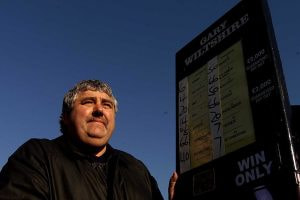How Entry Badge Became the First Greyhound Derby Champion
The 2023 Star Sports Greyhound Derby got underway at Towcester during the last weekend in May. The six-round knockout competition will now take place every Saturday until the £235,000 Derby decider is run on July 1st.

The UK’s first greyhound race meeting took place in Belle Vue, Manchester in July 1926. By the end of 1927, forty tracks were operating throughout the country. ©GettyImages
For most people, the ultimate accomplishment in greyhound ownership is winning the Derby. And for a greyhound to become one of the six elite finalists, the dog has to possess demon speed, track craft, stamina, and more than a little luck. These attributes are as important today as they were in 1927 – the year the first English Greyhound Derby was run.
E.B. Consolidated Track and Field
At that time, greyhound owners – amongst the most affluent people in 1920s society – patronized the sport of coursing. And they had to be persuaded that not only would their pride and joy chase a newfangled mechanical hare but also convinced that people would support this novel spectacle.
One man who helped to consolidate track racing was Edwin Baxter. A respected pillar of the coursing world, he was the owner of an extensive breeding kennel in Sarre, Kent, where he was the President of the Isle of Thanet Coursing Club.
All Baxter-owned greyhounds could be easily identified as their names carried the initials of their owner, E.B. This system of naming greyhounds was devised at a 1776 meeting of the Swaffham Coursing Club.
It was a simple yet effective method of providing a miscellany of useful information to interested parties, such as a dog’s breeding, training, and even an estimated value. The system gradually phased out by about 1935 when suffixes and prefixes became popular.
Badge Was Sent to the City
Edwin Baxter’s breeding kennels housed a brood-bitch named Beaded Nora that he had acquired for 40 guineas. As the result of a mating with Jamie, a fashionable sire of the time, she delivered a litter of three dogs and one bitch in June 1924.
Two of the pups, Edna Best – named after a famous actress – and Enamel Box, naturally progressed to coursing. However, Entry Badge failed to meet the high standards expected of him in the one-on-one field sport.
Entry Badge was therefore sent to the newfangled experiment, the oval racetrack, and the brindled colored dog made his debut at the first-ever meeting held in London’s White City Stadium on June 20th, 1927.
White City Stadium, home of the Greyhound Derby from 1927 (won by Entry Badge) to 1984 (when Whisper Wishes prevailed). The stadium, built for the 1908 Summer Olympics, was demolished in 1985 pic.twitter.com/MdlDK7iU5g
— Sports & Betting History by BestBettingSites (@CDCHistory) September 25, 2018
That day, a crowd of 50,000 people witnessed a greyhound named Charlie Cranston enter the record books as the track’s first-ever winner. But it was Entry Badge who took the feature contest, the White City Cup.
The Game Was Here to Stay
Enjoying the new spectacle, when the first Greyhound Derby came around four months later, Baxter was the owner of three dogs in the final. It was Entry Badge, trained locally by Joe Harmon, who justified Greyhound betting odds of 1/4 in the 500-yard contest. He won by six lengths ahead of Baxter’s other two dogs called, in keeping with the E.B. initials, Ever Bright and Elder Brother.
Before an estimated 100,000 racegoers, Baxter received an ovation from the crowd when going on to the track to receive his £1,000 prize and a Gold Cup presented by a famous American heiress who married into the English aristocracy, Margaretta Finch-Hatton, the Countess of Winchilsea.
After the race, Baxter told reporters: “I think the new game has come to stay. It is great fun.” Entry Badge later went on to win the Evening News Cup and the Daly Mirror £200 Challenge Trophy.
Towards the end of the year, the GRA (Greyhound Racing Association) produced the first volume of their greyhound register. It contained the names of 904 greyhounds, and the first owner to take advantage of the register was Edwin Baxter. Appropriately the first certificate was issued to the first Derby winner.
Parading the First Derby Hero
Entry Badge was a handsome dog who might have been successful in the show ring – showing dogs was another popular pastime during the period – but his owner had little respect for parading greyhounds for their physique.
The inaugural Derby winner remained a track dog for the rest of his career and won 11 of his 12 subsequent starts. Sent to stud for a fee of £15 guineas, in his relatively short stud career, Entry Badge served just 14 bitches.
His owner failed to complete a double by winning coursing’s centerpiece Waterloo Cup. However, Baxter did win the Waterloo Plate in 1927 with Echo Back. Twenty years later, his son, Edwin Baxter, Jnr., won the 1947 Waterloo Cup with a greyhound named Constable.
As for the Greyhound Derby …it is still going strong!




